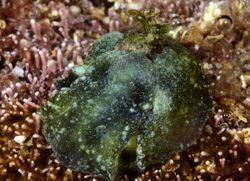Biology:Smaragdinella calyculata
| Smaragdinella calyculata | |
|---|---|

| |
| Scientific classification | |
| Domain: | Eukaryota |
| Kingdom: | Animalia |
| Phylum: | Mollusca |
| Class: | Gastropoda |
| Subclass: | Heterobranchia |
| Order: | Cephalaspidea |
| Family: | Haminoeidae |
| Genus: | Smaragdinella |
| Species: | S. calyculata
|
| Binomial name | |
| Smaragdinella calyculata (Broderip & G. B. Sowerby I, 1829)
| |
| Synonyms | |
| |
Smaragdinella calyculata, also called calyx bubble shell, is a small shelled slug common on rocky shores in the Indo-Pacific including Hawaii.[1][2]
Description & Biology
The Smaragdinella calyculata are marine bubble-shelled slugs.[3] The shell of the slug is flat and solid, allowing it to attach onto rocks along the shore.[3] The shell is brownish green with shades of white.[3] The large headshield is wide in the front, narrowing slightly to form a rounded end.[3] The upper whorl is absent, except for a spoon-shaped projection from the columella.[3] On each side of the shell, a foot extends into a large lateral lobe, the parapodia, which fold over, partially enclosing the shell, which lies exposed on the back of the animal.[3] The chemosensory Hancock's organs are brown and form a thin wrinkled ridge in the areas between the foot and the headshield on each side of the head.[3] The penial opening is on the right anterior corner of the head.[3] A ciliated seminal groove runs back to the genital opening at the anterior end of the mantle cavity opening.[3] They are grazers, which are consumers that feed on organisms on the bottom levels of the food chain.[4] They are herbivorous.[3]
Distribution
Smaragdinella calyculata are found in the Hawaiian Islands and the Indo-Pacific regions.[5] The Indo-Pacific region is a geopolitical area that spans two regions of the Indian Ocean and the Pacific Ocean.[6] Stretching from the west coast of the United States to the west coast of India, the Indo-Pacific is a 24 nations regional framework comprising the tropical waters of the Indian Ocean, the western and central Pacific Ocean, and the seas connecting the two in the general area of Indonesia.[6] Some examples of locations in the Indo-Pacific regions are China and Japan.[5]
Habitat
A majority of calyculata live in marine benthic zones.[7] Marine benthic zones are regions of the ocean that encompasses the seafloor and includes regions as shores, littoral or intertidal areas, marine coral reefs, and the deep seabed.[7] It lives at the same place on the shore as many limpets, and its compact shape and large muscular foot make it difficult to pry the animal off the rock at low tide.[3] Most calyculata were discovered in low water near shores, attached onto various rocks and coral reefs.[3]
References
- ↑ Hoover, John P. (1998). Hawai'i's sea creatures : a guide to Hawai'i's marine invertebrates. [Honolulu, Hawaii]: Mutual Pub. ISBN 1-56647-220-2. OCLC 41975146. https://www.worldcat.org/oclc/41975146.
- ↑ MolluscaBase eds. (2023). MolluscaBase. Smaragdinella calyculata (Broderip & G. B. Sowerby I, 1829). Accessed through: World Register of Marine Species at: https://www.marinespecies.org/aphia.php?p=taxdetails&id=590786 on 2023-01-12
- ↑ 3.00 3.01 3.02 3.03 3.04 3.05 3.06 3.07 3.08 3.09 3.10 3.11 jurisdiction=New South Wales; corporateName=Australian Museum; author=Rudman, W. B. (2010-07-15). "The Sea Slug Forum - Smaragdinella calyculata" (in en). http://www.seaslugforum.net/showall/smarcaly.
- ↑ "grazer" (in en). https://www.wikidata.org/wiki/Q37619060.
- ↑ 5.0 5.1 "Smaragdinella calyculata: main page". http://seaslugsofhawaii.com/species/Smaragdinella-calyculata-a.html.
- ↑ 6.0 6.1 "Indo-Pacific Region" (in en-US). https://ceoworld.biz/indo-pacific/.
- ↑ 7.0 7.1 "emerald bubble snail data - Encyclopedia of Life". https://eol.org/pages/46448456/data.
- Gosliner, T. (1987). Nudibranchs of Southern Africa: A Guide to Opisthobranch Molluscs of Southern Africa. Sea Challengers, Monterey, California.
External links
- Quoy, J. R. C. & Gaimard, J. P. (1832–1835). Voyage de la corvette l'Astrolabe : exécuté par ordre du roi, pendant les années 1826-1827-1828-1829, sous le commandement de M. J. Dumont d'Urville. Zoologie.
- Broderip, W. J. & Sowerby, G. B. I. (1829). Observations on new or interesting Mollusca contained, for the most part, in the Museum of the Zoological Society. Zoological Journal. 4: 359-379, pl. 9
- Adams, A. (1847). Notes on certain molluscous animals. Proceedings of the Zoological Society of London. 1847: 19–24.
- Adams, A. (1850). Monograph of the family Bullidae. In G. B. Sowerby II (ed.), Thesaurus conchyliorum, or monographs of genera of shells. Vol. 2 (11): 553-608, pls 119–125. London
- Gray, J. E. (1850). [text]. In: Gray, M. E., Figures of molluscous animals, selected from various authors. Longman, Brown, Green and Longmans, London. Vol. 4, iv + 219 pp. (August)
- Sowerby, G. B. II. (1870). Monograph of the Genus Linteria. In: Conchologia Iconica, or illustrations of the shells of molluscous animals, vol. 18, plate and unpaginated text. L. Reeve & Co., London.
- Quoy, J. R. C. & Gaimard, J. P. (1832–1835). Voyage de la corvette l'Astrolabe : exécuté par ordre du roi, pendant les années 1826-1827-1828-1829, sous le commandement de M. J. Dumont d'Urville. Zoologie.
- Adams, A. (1850). Monograph of the family Bullidae. In G. B. Sowerby II (ed.), Thesaurus conchyliorum, or monographs of genera of shells. Vol. 2 (11): 553-608, pls 119–125. London, privately published.
- Yonow N. & Jensen K.R. (2018). Results of the Rumphius Biohistorical Expedition to Ambon (1990). Part 17. The Cephalaspidea, Anaspidea, Pleurobranchia, and Sacoglossa (Mollusca: Gastropoda: Heterobranchia). Archiv für Molluskenkunde. 147(1): 1-48
Wikidata ☰ Q14361395 entry
 |

